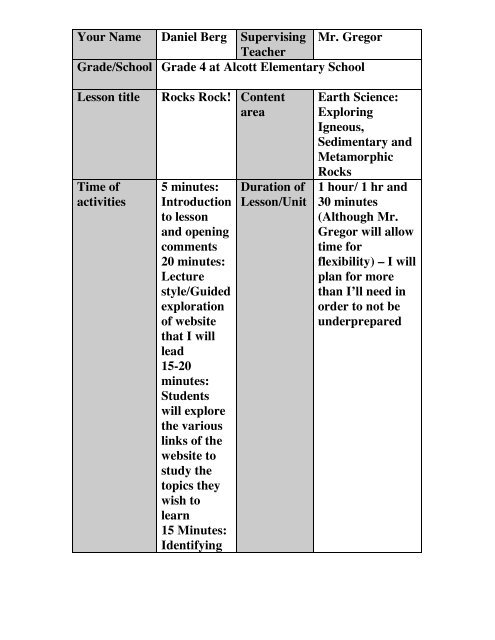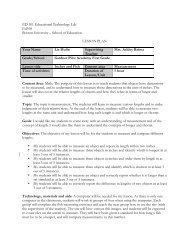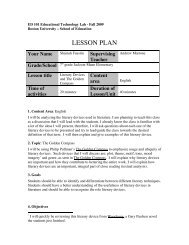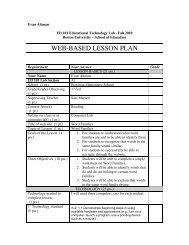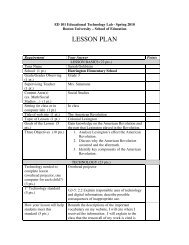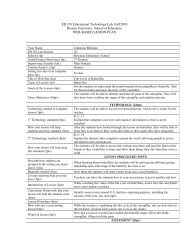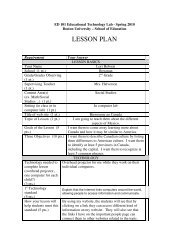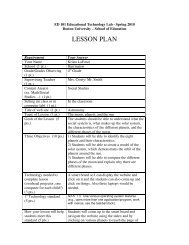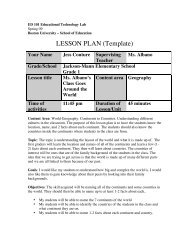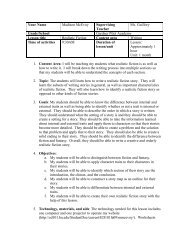full lesson plan - ED101
full lesson plan - ED101
full lesson plan - ED101
You also want an ePaper? Increase the reach of your titles
YUMPU automatically turns print PDFs into web optimized ePapers that Google loves.
Your Name Daniel Berg Supervising Mr. GregorTeacherGrade/School Grade 4 at Alcott Elementary SchoolLesson titleTime ofactivitiesRocks Rock! Contentarea5 minutes:Introductionto <strong>lesson</strong>and openingcomments20 minutes:Lecturestyle/Guidedexplorationof websitethat I willlead15-20minutes:Studentswill explorethe variouslinks of thewebsite tostudy thetopics theywish tolearn15 Minutes:IdentifyingDuration ofLesson/UnitEarth Science:ExploringIgneous,Sedimentary andMetamorphicRocks1 hour/ 1 hr and30 minutes(Although Mr.Gregor will allowtime forflexibility) – I will<strong>plan</strong> for morethan I’ll need inorder to not beunderprepared
ock activityin groupswith realsamples5-10Minutes:Groups willpresenttheirfindings tothe classContent Area:The content of the <strong>lesson</strong> is igneous, sedimentary and metamorphic rocksand their relation to Earth Science.Topic:The topic of the <strong>lesson</strong> is the 3 types of rocks and their definingcharacteristics. Skill sets of observation and discussion will be utilized throughoutthe <strong>lesson</strong>. Students will learn how to distinguish rocks based on key differences intype, and will learn how to articulate their ideas in an interactive setting usingdiscussion as well as the website. Students will learn what the specific types of rockslook like and where they are found.Goals:My aims for my students are both intellectual and social. I want my studentsto utilize the technology of the website effectively in able to understand the <strong>lesson</strong>. Ialso want my students to express their ideas within small groups and learn tocooperatively work to discover new information about the 3 types of rocks. The goalof the <strong>lesson</strong> to encourage independent study of earth science in the non-traditionalhomework assignments that the students complete weekly.Objectives:1. Students recognize that there are 3 types of rocks2. Students are able to tell differences between the 3 types of rocks3. Students have an understanding of where the different types of rocks areformed4. Students have a basic understanding of how the rocks formed5. Students will be able to name examples of each type of rock6. Students will understand that rocks are composed of different mineralsTechnology, Materials, and Aids:
My <strong>lesson</strong> will incorporate a variety of support materials ranging fromtechnology to hands-on activities. I <strong>plan</strong> on borrowing samples of each type of rockfrom my Earth science professor in order to construct an interactive activity for thestudents. I will utilize the active board in the classroom in order to gain access to thewebsite I create, and I have booked space in the computer lab so that the studentscan explore the website individually. The number of samples will depend on howmany groups I will seek to create, but every student will have their own computer touse in the computer lab.Procedure/Methods:a. Overview: During the <strong>lesson</strong> the website will be utilized in both independentresearch by the students as well as guided exploration that I will lead. Afterthe website is used, I have <strong>plan</strong>ned an interactive activity that will utilize realsamples of rock. In groups the students will apply what they have learned tofigure out what type of rock their unknown sample is.b. Introduction: I will briefly introduce the <strong>lesson</strong> with opening comments. Iwill thank the class for teaching me how to be a teacher, and try to gainexcitement and enthusiasm by telling them about my own excitement to beteaching a <strong>lesson</strong> for the first time.c. Activities:a. Introductioni. Opening comments and introduction of topicb. Guided exploration of websitei. Igneous Rocks (Formation, environment, key characteristicsand examples)ii. Sedimentary Rocks (Formation, environment, keycharacteristics, examples)iii. Metamorphic Rocks (Formation, environment, keycharacteristics, examples)iv. Open discussion for questionsc. Independent exploration of websitei. Students will explore topics of their choice to enhance theirunderstandingd. Assessment on Websitee. Group Activity: Identifying Rocksi. Students will be divided into approximately 5 groups, each with aunique sample of rock.ii. Students will use the information they discovered from the websiteand decide as a group what type of rock their unknown sample is.f. Concluding Statements and final questionsi. Thank the class for allowing me to teachii. Clarify any remaining questionsd. Follow-up: The <strong>lesson</strong> will connect to their learning outside of the classroombecause the students will be assigned non-traditional homework relating to the<strong>lesson</strong>. Every week the students complete non-traditional homework of the topic of
their choice. The assignment will allow students to explore the topics they want toexplore in order to make their learning more student-centered and personal.Technology Frameworks:G3-5: 1.10 Do simple searches of existing databases (e.g., online library catalog,electronic encyclopedia).G3-5: 1.18 Use age-appropriate Internet-based search engines to locate and extractinformation, selecting appropriate key words.G3-5: 2.5 Work collaboratively online with other students under teachersupervision.G3-5: 3.3 Evaluate Internet resources in terms of their usefulness for research.Assessment PlanObjectives:1. Students recognize that there are 3 types of rocks2. Students are able to tell differences between the 3 types of rocks3. Students have an understanding of where the different types of rocks areformed4. Students have a basic understanding of how the rocks formed5. Students will be able to name examples of each type of rock6. Students will understand that rocks are composed of different mineralsI would like my students to obtain knowledge-based goals andunderstanding of the <strong>lesson</strong>. I want my students to be able to name andrecognize the different types of rocks and be able to communicate essentialinformation. Because of their age, I think that understanding is also areasonable goal to strive for in the <strong>lesson</strong>. The interactive activity I <strong>plan</strong>nedwith real rock samples will test my students’ abilities to classify, describe,recognize and discuss the three types of rocks.Multiple Choice Questions:1. The Grand Canyon is mostly:a. Igneous Rockb. Metamorphic Rockc. Layers of Sedimentary Rockd. Fruity pebbles2. Which of these is NOT caused by a volcanic eruption:a. Alien Invasionb. Earthquakesc. Tsunamisd. Mudflows3. Which of these characteristics make rocks metamorphic:a. Cold temperaturesb. No pressure
c. Smooth rock with no stripesd. Very high temperature4. Sedimentary Rocksa. Are made when magma erupts from a volcano and coolsb. Are made when rocks transform into new rocksc. Are made by peopled. Are held together by a natural cement5. Magma and Lava are:a. The sameb. Magma is lava that has erupted from volcanoesc. Lava is magma before it is erupted from a volcanod. Very coldOTHER QUESTIONS:Bill Nye Video:1. Made by ____, ______, and Water we rock hard but rocks rock harder!a. Wind, Sunb. Pressure, Heat2. Igneous Rocks form inside the ground made when melted rocks_______a. Cool downb. Heat up3. Sedimentary Rocks are made from dust like sandstone, …….and rust ______ and______ break them down cut big canyons in the ground.a. Wind, Waterb. Acid, WindIgneous Rocks:What is the difference between lava and magma?Name two things that you learned about volcanoes:Sedimentary Rocks:EXPLORE THE GRAND CANYON!Metamorphic Rocks:The best way to tell if a rock is metamorphic is to look for stripes in the rock. Therock below is Gneiss. Do you think it’s metamorphic?The rock pictured below is a shale. Do you think it’s metamorphic? If not whichtype of rock do you think it is?ANSWER KEY:
Daniel BergED 101Lesson Plan


